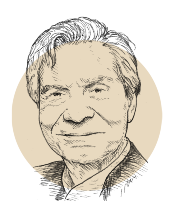The French congressman Edouard de Laboulaye began raising funds in 1865 in order to give the Americans the Statue of Liberty. The gift symbolized friendship between the two countries, but was just as much a political message for French citizens. Napoloon III was emperor at the time, and Laboulaye was campaigning for the adoption of the U.S. republican constitution in France. Upon arriving in New York, the Statue of Liberty waited for ten years for the city hall to decide where to put it and American philanthropists to finance its base – which is higher than the statue itself. During this time, Laboulaye and Victor Hugo – who was supposed to write the text on the base – both passed away, and American poet Emma Lazarus was commissioned instead.
In an attempt to reciprocate, a number of American philanthropists then gave Paris a smaller replica of the original statue, which now stands on the Ile aux Cygnes on the Seine River. They also offered the city an identical reproduction of the statue’s torch, which sits on the Place de l’Alma. This was where Lady Di was killed in a car accident, and passers-by are now convinced the statue is a memorial for the British princess.
Following this pattern of gifts and misunderstandings, the same scenario is being played out once again. Obama’s former ambassador to Paris, Jane Hartley, persuaded American artist Jeff Koons to give the French capital one of his contemporary creations. The result is a monumental sculpture estimated at three million euros, and no one wants to pay for it. The mayor of Paris, Anne Hidalgo, will be in New York this week, where she will ask the city’s former mayor, Michael Bloomberg, to fund the bizarre gift. This funding initiative is part of the Paris Foundation, set up in 2015 to raise money from philanthropists looking to finance cultural projects in the French capital.
The statue would be excellent publicity for the (incredibly wealthy) American artist, whose kitsch work is loved by many in France. However, a number of Parisian artists and intellectuals say otherwise. They have no wish to see the gigantic bouquet of tulips, crafted in bronze and steel and painted in garish colors, showcased on the square in front of the Palais de Tokyo, the city’s modern and contemporary art museum. If Michael Bloomberg pays up, and if this monstrous arrangement is installed, there is already a group of Parisians prepared to vandalize Koon’s work with paint and graffiti.
Anne Hidalgo – who has never accepted a single work by a French artist in the streets of Paris – still has time to refuse this gift. Alternatively, she could find an American artist more in keeping with the Parisian landscape, and a group of generous patrons.












